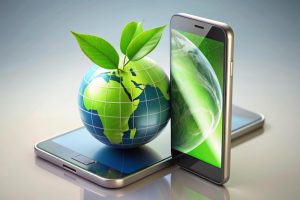Electronics and Sustainability: Navigating Toward a Greener Future

The consumer electronics industry stands at the forefront of technological innovation, continuously introducing cutting-edge gadgets that shape our daily lives. These advancements have revolutionised our communication, work, and entertainment, from smartphones and laptops to smart home devices and wearables. However, alongside these benefits comes a significant environmental footprint. Consumer electronics production, use, and disposal contribute to resource depletion, pollution, and electronic waste (e-waste) accumulation. Consumers and manufacturers increasingly focus on sustainability in the electronics sector in response to growing environmental concerns.
The Environmental Impact of Consumer Electronics
Consumer electronics have a complex lifecycle spanning raw material extraction to disposal. Each stage of this lifecycle has environmental implications:
- Resource Extraction: Mining metals and minerals, including rare earth elements essential for electronics production, often involve environmentally damaging practices such as deforestation, habitat destruction, and water pollution.
- Manufacturing Processes: Electronics manufacturing requires substantial energy and water consumption, as well as the use of toxic chemicals and materials. These processes contribute significantly to carbon emissions and pollution.
- Product Use: While energy-efficient designs have reduced the environmental impact during the use phase of electronics, the increasing number of devices and their growing energy demands still pose challenges.
- E-waste: The disposal of old electronics generates e-waste, which is a global issue due to its toxic components and the challenges associated with recycling and proper disposal.
Advancements Towards Sustainability
Despite these challenges, the consumer electronics industry is actively pursuing sustainability initiatives:
- Design for Sustainability: Manufacturers incorporate eco-friendly materials such as recycled plastics and metals into their products. Designing products for durability and repairability also extends their lifespan and reduces the need for replacements.
- Energy Efficiency: Efforts to improve energy efficiency in electronics have led to innovations in low-power processors, displays, and energy management systems, reducing operational costs and environmental impact.
- Circular Economy Initiatives: Some companies are adopting circular economy principles, aiming to create closed-loop systems where products are designed to be reused, refurbished, or recycled at the end of their life cycle.
- E-Waste Management: Initiatives include take-back programs, where manufacturers facilitate collecting and recycling old devices. These programs help recover valuable materials and reduce the environmental impact of e-waste disposal.
The Role of Blockchain and Renewable Energy Technologies
Emerging technologies such as blockchain and renewable energy are crucial in advancing sustainability in the consumer electronics sector.
- Blockchain for Transparency and Traceability: Blockchain technology can enhance transparency in the supply chain by providing a decentralised and immutable record of transactions. This ensures that raw materials and components are sourced responsibly. For instance, blockchain can verify the origin of conflict-free minerals and ensure compliance with environmental regulations. By improving traceability, manufacturers can make more sustainable sourcing decisions and provide consumers with greater confidence in the sustainability of their products.
- Renewable Energy Integration: Renewable energy technologies, such as solar and wind power, can be integrated into the production and operation of consumer electronics. For example, devices with built-in solar panels can harness solar energy to reduce reliance on traditional power sources. Additionally, manufacturing facilities powered by renewable energy significantly lower the carbon footprint of production processes. Innovations like these contribute to a more sustainable life cycle for electronic devices.
Consumer Role in Promoting Sustainability
Consumers also play a crucial role in promoting sustainability within the electronics industry:
- Educated Purchasing Decisions: Consumers can choose products from companies prioritising sustainability, such as eco-certifications or transparent environmental policies.
- Product Longevity: Opting for durable products and considering factors like repairability and upgradability can extend the lifespan of electronics and reduce overall consumption.
- Proper Disposal: Responsibly recycling old electronics ensures that valuable materials are recovered and hazardous substances are managed safely.
- Energy Efficiency Practices: Simple actions like turning off devices when not in use and optimising energy settings can reduce energy consumption.
Innovations Driving Sustainability
Looking ahead, emerging technologies and innovative approaches are set to further advance sustainability in consumer electronics:
- Biodegradable Electronics: Researchers are exploring materials and manufacturing techniques that enable electronics to degrade naturally at the end of their life, reducing e-waste.
- Renewable Energy Integration: Advances in energy harvesting technologies, such as solar cells and kinetic energy harvesting, could enable devices to generate their own power sustainably.
- Blockchain for Transparency: Blockchain technology offers potential solutions for tracking materials throughout the supply chain, enhancing transparency and accountability in sustainable sourcing practices.
- Collaborative Efforts: Industry collaborations and partnerships among manufacturers, recyclers, and policymakers are essential for developing comprehensive solutions to sustainability challenges.
Policy and Regulatory Landscape
Government policies and regulations also play a critical role in driving sustainability in the electronics industry. Different countries have implemented various e-waste regulations and policies that significantly impact the industry:
- European Union (EU): The EU’s Waste Electrical and Electronic Equipment (WEEE) Directive mandates that manufacturers take responsibility for the disposal and recycling of their products. The directive sets collection, recycling, and recovery targets for all types of electrical goods, aiming to reduce e-waste and promote resource recovery.
- United States: While there is no federal e-waste regulation, several states have enacted their own laws. For example, California’s Electronic Waste Recycling Act requires manufacturers to finance the collection and recycling of certain electronic devices. These state laws vary in scope and requirements, leading to a patchwork of regulations.
- China: China’s Regulation for the Administration of the Recovery and Disposal of Waste Electrical and Electronic Products (often referred to as the China WEEE Regulation) requires manufacturers to collect and properly dispose of e-waste. The regulation aims to mitigate environmental pollution and promote the recycling and reuse of materials.
- Japan: Japan’s Home Appliance Recycling Law requires consumers to pay a recycling fee when disposing of certain appliances. Manufacturers and retailers are responsible for collecting and recycling these items, ensuring proper resource management and waste reduction.
- India: India’s E-Waste Management Rules impose extended producer responsibility (EPR) on manufacturers, requiring them to collect and recycle e-waste. These rules aim to improve e-waste management practices and reduce environmental impact.
These regulations impact the industry by compelling manufacturers to develop sustainable practices, invest in recycling infrastructure, and innovate in product design to meet regulatory requirements.
Challenges and Future Directions
Despite progress, several challenges remain on the path to achieving sustainability in consumer electronics:
- Complex Supply Chains: Electronics supply chains are global and complex, making tracking and managing environmental impacts throughout products’ lifecycles is challenging.
- Technological Obsolescence: The rapid pace of technological advancement and consumer demand for new features often lead to shorter product lifecycles and increased e-waste.
- Consumer Behavior: Encouraging widespread adoption of sustainable practices among consumers, such as proper disposal and energy-efficient use, remains a challenge.
- Resource Constraints: The availability of critical resources, such as rare earth elements, poses challenges for sustainable manufacturing practices.
Conclusion: Toward a Sustainable Tech Future
In conclusion, the journey towards sustainability in the consumer electronics industry is multifaceted and ongoing. While significant strides have been made in designing more eco-friendly products and implementing recycling programs, addressing electronics’ environmental impact requires continued innovation, collaboration, and stakeholder commitment. Consumers, manufacturers, policymakers, and environmental organisations all have a role to play in shaping a greener future for consumer electronics.
We can collectively drive positive change by making informed choices, advocating for sustainable practices, and supporting companies prioritising environmental stewardship. Together, we can navigate the complexities of technology and sustainability, ensuring that future generations can enjoy the benefits of consumer electronics without compromising the health of our planet. The recent Consumer Electronics World Expo 2024 showcased this initiative, highlighting the latest sustainable technologies and fostering essential discussions on responsible industry innovation. The event demonstrated a collective commitment to a greener future, reinforcing that consumer electronics is not just an industry but an initiative towards sustainability and environmental stewardship.
More News
What Makes Some Appliances Household Names That Last for Generations
Some products don’t just enter homes they transform them. The low hum of a refrigerator, the quick heat of a microwave, or…View More
Every Device Wants to Be a Platform: Why Ecosystems Beat Standalone Products
Walk through any major tech exhibition and you’ll notice something striking. Nobody is simply showing off a phone, a fridge, or a…View More
What India’s Booming Middle Class Means for Consumer Electronics Brands
India’s middle class is no longer an emerging economic force, it’s a defining one. Over the last decade, this segment has rapidly…View More
India’s Love for Smartphones: Market Trends, Innovations & Future Outlook
India has emerged as one of the world’s largest and most dynamic smartphone markets. With over 750 million smartphone users and counting,…View More
Why Consumer Electronics Trade Shows Are Crucial for Industry Professionals?
Consumer electronics is an ever-evolving industry, with groundbreaking innovations emerging at a rapid pace. For industry professionals—whether manufacturers, distributors, retailers, or tech…View More
Download
Register Now
Show Countdown
Bharat Mandapam (Pragati Maidan), New Delhi, India
Date will be announced soon.








